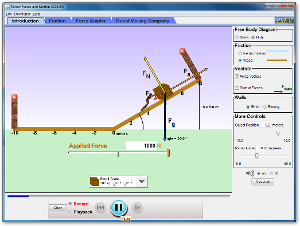Set up the equipment, attaching a Barbie on a cord to the force probe. Remember that you need to tell the Logger Pro what type of force probe is attached...it will not do so automatically. Determine Barbie's Fw, and F(net) and Fup Your calculations must be shown at the moment that Barbie is at the maximum extension of the rope. All calculations must be summarized in a table when you turn in the lab.
Procedures:
Produce as least 4 different graphs by dropping Barbie with different cords. Use the evidence to collect a rationale for the common use of rubber as a bungie cord, and whether it is supported by your data.
Sketch, describe, print or save your graphs for each "jump". Clearly indicate which cord or material was used. Also include information such as the amount of force and the time over which the force was applied. Record any relevant observations you saw during the jump.
Individual Conclusions (1/2 to 1 page, plus tables)
Describe the ideal harness for a bungie jumper so that net force is distributed across the barbie. This should be based on data you gathered when Barbie parachuted. Explain how the net time for the Barbie to stop jumping can affect a force distribution. (Think carefully: F=ma, but a = change in velocity/change in time)
Based on your data, is it possible to argue that there is a better material for a bungie jump than rubber? Why or why not?
What questions arose in the lab? What information have you found?
Monday, November 28, 2011
Monday, November 21, 2011
Understanding the Hill
Today, we're going to push something on a hill, and balance it on a hill.
This requires us to look at the force vector of gravity in a component fashion.
=======================
1. Joe is going off to college and is loading his file cabinet onto the moving truck by sliding it up a ramp with a 10 degree angle.
a. Sketch what you think the free body diagram would look like for the file cabinet and explain your reasoning.
b. Use Ramp: Force and Motion to simulate Joe’s situation. Compare your free body diagram to the simulation and make any corrections to your drawing and reasoning.
c. Investigate the simulation to see what effects how hard Joe must push to move the cabinet up a ramp.
d. Describe your experiments and results including the free body diagrams.
e. Draw the free body diagrams for the cabinet if it were being pushed on a flat surface and if it were being lifted straight up. Compare those to the ones you observed on the ramp, and then describe the differences and similarities.
2. Next, Joe wants to load his crate of books.
a. Predict what you think the free body diagram would look like.
b. Explain what might cause similarities and differences between Joe moving the crate versus the file cabinet.
c. Test your prediction and thoughts using the simulation.
d. Describe your experiments and results including the free body diagrams.
3. Think of some other things that Joe might want to move using a ramp and explain what he would have to consider when thinking about how hard to push.
4. Joe has some friends that want to help, but they’re not as strong. How do you think the ramp design be changed so they could help? Verify or adjust your ideas by experimenting with the simulation.
5. Joe wants to stop on the ramp to catch his breath. Would he be better off stopping on a rough spot on the ramp or a smooth spot? Verify or adjust your ideas by experimenting with the simulation.
6. Joe is moving his refrigerator to take to college and he begins by pushing it across the wooden kitchen floor.
On a flat surface like the floor, how do you calculate how hard he needs to push? Draw a free body diagram to help explain your answer and use the simulation Ramp: Force and Motion to check your ideas. Record the minimum force Joe would have to use to move the refrigerator on the kitchen floor.
7. Later, Joe is ready to load his refrigerator onto the moving truck.
a. Explain how he would calculate how much force to use to lift the refrigerator straight up into a truck.
b. Joe starts thinking about easier ways to get it in the truck and remembers he has some wood that he could use to make a ramp. How could he calculate the minimum force needed to push it up the ramp?
c. Use the simulation to check your ideas by running experiments with different objects at several angles. Make a data table including several trials with the calculations.
Ramp
angle
Weight (Fg)
Fgravity
Ffriction
Fapplied
Resulting motion (stationary, down ramp or up ramp)
Fnet calculation
Wednesday, November 9, 2011
Thursday, 11/10/11
You should have two bumper tests, with the data saved to a computer desktop and/ or printed. Make sure you have the data tables as well as the graphs.
You should be done with the review sheets. We'll be going over them Friday.
You should work on this activity when you get done. It is due Monday at the beginning of class. It must be handed in INDIVIDUALLY to receive credit, even if you collaborate on the problem.
You should be done with the review sheets. We'll be going over them Friday.
You should work on this activity when you get done. It is due Monday at the beginning of class. It must be handed in INDIVIDUALLY to receive credit, even if you collaborate on the problem.
Subscribe to:
Posts (Atom)


